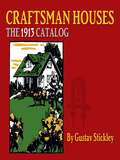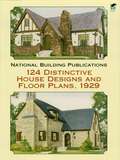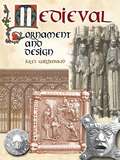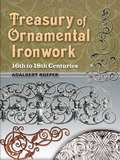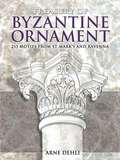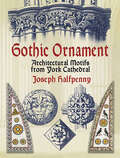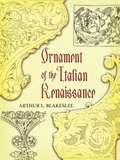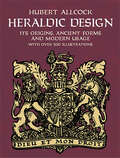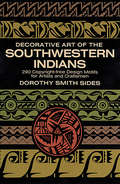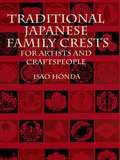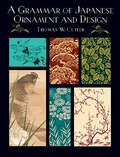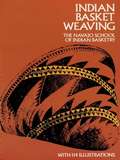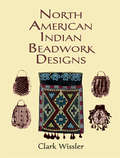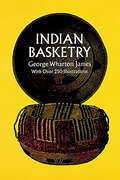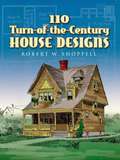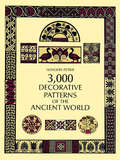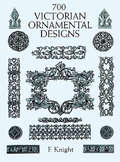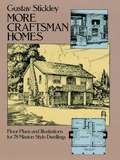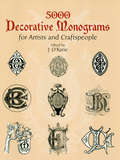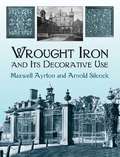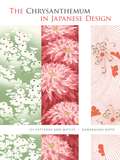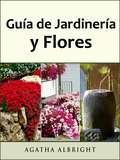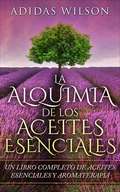- Table View
- List View
Craftsman Houses: The 1913 Catalog
by Gustav StickleyGustav Stickley pioneered a form of architecture based on beauty, simplicity, utility, and organic harmony. This inexpensive reprint of a very rare catalog testifies to the enduring charm of his designs. It comprises numerous architectural drawings and photographs of Mission-style homes, including floor plans and descriptive text."Planned for comfort, convenience, and economy," each of these homes features a simple arrangement of rooms and sturdy structural features. Combining good taste with practicality, they offer openness for common household life, as well as sufficient seclusion for privacy. Models range from a two-family house of cement or stucco to a nine-room cottage of brick and shingles and a seven-room country bungalow. Restorers of old houses, preservationists, and students of American architectural history will prize this well-illustrated treasury of authentic plans and details.
124 Distinctive House Designs and Floor Plans, 1929
by National Building PublicationsAn annual publication intended as a reference work for contractors, suppliers, architects, and homeowners, the 1929 Home Builders Catalog offered a beautifully illustrated look at a variety of homes. Painstakingly reproduced from a rare edition, this volume offers old-house restorers, preservationists, and lovers of 1920s architecture an authentic view of American homes of the era.
Medieval Ornament and Design
by Jules GailhabaudThis lavish archive of exquisite engravings and designs--originally created in the mid-nineteenth century for the professional artist and architect--contains some 200 splendid illustrations, expertly adapted from decorative as well as utilitarian features of medieval cathedrals, churches, tombs, houses, shops, public buildings, and other structures. Encompassing a wide variety of styles, the designs include finely detailed panels, gawking gargoyles, marvelously carved pillars and pedestals, exquisite ironwork patterns, decorative stonework, magnificent stained glass windows, moldings enhanced with intricately woven motifs, and much more.Artists, designers, and craftworkers will find wide use for these versatile, royalty-free illustrations. Students of architecture, art historians, and lovers of ornamental art will delight in the pure beauty of this magnificent collection.
Treasury of Ornamental Ironwork: 16th to 18th Centuries
by Adalbert RoeperSixty vintage black-and-white plates illustrate the history of German decorative ironwork from the16th to the 18th centuries. A hard-to-find celebration of the diversity and enduring beauty of Germany's handcrafted iron embellishments, this magnificent edition exhibits striking views of metal doors, balconies, window arches, gates, corner pieces, decorative accessories, and more, many wrought with gargoyles, human figures, and florals. A rich source of inspiration and an accurate, invaluable reference for art historians, architects, craftworkers, and designers.
Treasury of Byzantine Ornament: 255 Motifs from St. Mark's and Ravenna
by Arne DehliThe art of the Eastern Roman Empire and of its capital, Byzantium (Constantinople), found expression throughout the ancient world, particularly in Italian architecture. This superb archive of Byzantine ornament contains a wealth of decorative architectural elements derived from sixth- and seventh-century Italian buildings in Ravenna and in the Venetian church of St. Mark's.Depicted in more than 250 delicate line drawings are splendid perforated marble panels, intricately fashioned stone grilles and cornices, lavish candle brackets, elaborate stone mosaics for floors and ceilings, bronze window guards, as well as an abundance of decorative wreaths, rosettes, mouldings, and medallions.A multipurpose reference for students, artists, and designers, this archive of sumptuous, royalty-free designs will also serve as a rich source of inspiration for anyone working in the fine or applied arts.
Gothic Ornament: Architectural Motifs from York Cathedral
by Joseph HalfpennyThese royalty-free motifs feature exquisite specimens of the sculptured ornaments from northern Europe's largest medieval cathedral. The Cathedral and Metropolitical Church of St. Peter in York, popularly known as York Minster, was founded as a missionary church. Its soaring Gothic architecture and vast interior, parts of which date back to the 13th century, feature some of the best examples of the medieval craftsman's work to be found anywhere.This compilation consists of 175 illustrations, selected from throughout the cathedral. Like the building of the church itself, the ornaments were executed during different eras. This collection, reproduced from a rare 18th-century volume, offers artists and graphic designers an unusual selection of authentic architectural motifs from the Middle Ages.
Ornament of the Italian Renaissance
by Arthur L. BlakesleeThis glorious gallery of stunning architectural accents from Italy's Middle Ages has been assembled from a rare, early-twentieth-century publication: * Grotesques from carved panels of choir stalls* Breathtaking tombstone and ceiling ornaments * Sumptuous stone balcony panels... and much more, all reproduced in sixty richly detailed illustrations. Designers and artists of every variety will revel in this modestly priced treasury of authentic Renaissance style.
Heraldic Design: Its Origins, Ancient Forms and Modern Usage
by Hubert AllcockThrough the ages, as warfare and competitive rituals became more elaborate, heraldry evolved into an exact art and science. Used to denote accomplishments as well as the genealogies of outstanding individuals and families, these symbols survived the way of life that created them.This remarkably rich sourcebook of royalty-free designs describes the origins and ancient forms of heraldic devices, shields, and trademarks. Over 500 black-and-white drawings trace the history and meaning of the coat, shield, crests, helmets, blazonry, and "attitudes and attributes" of symbols, with considerable attention given to devices such as beasts, monsters, and human and part-human figures. American, British, French, Russian, and other coats of arms are displayed, as are insignias of the Pope and clergy, state seals, and emblems of many modern institutions. In addition to personal, commercial, and family arms, chapters also provide information on the use of heraldry in advertising, brand-labeling, and related fields.A valuable visual reference for anyone interested in genealogy, these handsome images will add a touch of class to a variety of art and craft projects.
Decorative Art of the Southwestern Indians
by Dorothy S. SidesThe decorative art of the Indians of the American Southwest has long been recognized as one of the most beautiful art traditions in the primitive world. It demonstrates a technical skill with simple materials, a symbolic richness, and a faculty for creating rich effects by the imaginative use of ornament that are all almost unique. Museums use Pueblo ceramics for display pieces, and modern artists and crafters have turned eagerly to the handwork of prehistoric Indian women for inspiration and working ideas.Mrs. Dorothy Sides, a noted artist and collector, has gathered together and redrawn in black and white nearly 300 examples of the finest authentic Southwestern Indian decoration that she has seen in a lifetime of study. She has not limited her selection to one period or style, however; to make her book as useful as possible, she has selected material ranging from the thirteenth century great geometric art of the Pueblos to the handcrafts carried on by the nomadic and Pueblo peoples of the present.The main emphasis of this volume is on ceramic decoration, and Mrs. Sides includes pieces from the rich archeological sites of Pecos, Sikyatki, the Mimbres, and modern Pueblo pottery from Acoma, Zuni, Cochiti, and the Hopi. She also includes designs and motifs from the basketry of the Apache, Pima, and Papago; beadwork from the Mohave; authentic Zuni masks; Hopi kachina dolls; and sand paintings and blanket designs from the Navajo. This broad coverage of beautiful ornament illustrates many different art styles to fit every situation: geometric designs based upon balanced mirror fields of design, symbolic figures of the thunderbird, and modern stylizations. All is beautiful and imaginative.Any crafter working with ceramics will find this book indispensable as a source of rich, easily used, powerful design; workers in wood, weavers, metal workers, and leather workers will find that it will enlarge their decorative resources considerably. It also offers unusual and eye-catching designs for commercial artists who wish to do work suggesting travel, handcrafts, the Southwest, or the social sciences. Individual drawings are royalty-free and may be reproduced without fee or permission.
Traditional Japanese Family Crests: for Artists and Craftspeople
by Isao HondaOver 1,700 compact, graceful designs -- a traditional part of many Japanese family histories -- are featured in this handsome, versatile collection. Depicting plant, leaf, animal, and fan designs in circular motifs; astronomical images, and more, the authentic, royalty-free crests are ideal for use as spot illustrations in a variety of graphic projects.
A Grammar of Japanese Ornament and Design
by Thomas W. CutlerThe lovely images in this rare collection comprise one of the most comprehensive surveys of mid-19th-century Japanese art and ornamentation. Included are graceful details from landscapes, floral motifs, abstracts, illustratons of sea life, and other subjects-ideal for use in a host of art and craft projects. Over 300 figures on 65 plates.
Indian Basket Weaving
by Navajo School of Indian BasketryThe methods of Indian basket weaving explained in this excellent manual are the very ones employed by native practitioners of the craft. members of the Navajo School of Basketry have set down their secrets in clear and simple language, enabling even the beginner to create work that can rival theirs in grace, design, and usefulness.Beginning with basic techniques, choice of materials, preparation of the reed, splicing, the introduction of color, principles and methods of design, shaping the basket and weaves from many cultures, such as Lazy Squaw, Mariposa, Taos, Samoan, Klikitat, and Shilo, each accompanied by specific instructions. There are suggestions for the weaving of shells, beads, feathers, fan palms, date palms, and even pine needles, and recipes for the preparation of dyes.Examples of each type of basket are illustrated by photographs, often taken from more than one angle so that the bottom can be seen as well as the top and sides. Close-up photography of the various types of stitching, especially at the crucial stage of beginning the basket, is an invaluable aid to the weaver. In addition, the authors have provided line drawings which are exceptionally clear magnifications of the various weave patterns.Anyone who follows the lessons contained in this book will have a knowledge of basketry unattainable in any other way. They are so lucid and complete that the amateur as well as the experienced weaver will be able to manufacture baskets distinguishable from authentic native articles only in that they were not woven by Indians. For those who merely seek a broader knowledge of American Indian arts, the book provides a comprehensive introduction to the subject of basketry.
North American Indian Beadwork Designs
by Clark WisslerThis concise volume documents a fascinating and unique art form -- Native American beadwork. Including examples of handiwork from Eastern woodlands and Plains Indians, the author offers a clear, illuminating discussion of the origins, execution, and symbolism of Indian beadwork used to ornament belts, garters, pouches, and much more. Over 300 figures.
Indian Basketry
by George W. JamesSince it first publication in 1901, this pioneering study by George Wharton James, once a leading collector and authority, has become a valuable source book for American Indian basketry. From Poma mush baskets to Paiute dicing trays, Indian Basketry traces the origin, development, and fundamental principles of Indian basket designs for the major tribal units in Southwestern United States and Pacific Coast, with occasional comments on the basket weaving of a number of other North American tribes.Author of several books on the Southwest, George James has used his extensive experience in the field to compile indispensable information (much gathered directly through interviews with Indian basketmakers) covering nearly every aspect of Indian basketry: esthetics, designs, dyes, and coloration, weaving and stitching techniques (including the bamtush and dah-lah methods), basket types, tribal variation, and functional considerations, offering clear instructions for those who may be interested in reproducing these ancient American crafts. James also includes a description of various native weaving materials such as pine root, bark, sumac, willow, twigs, fern stalks, grass and palm fronds, with suggestions regarding the ways in which the Indians wove shells, feathers, beads, leather, and pine needles into their basket designs.The book is a valuable aid for the artist, designer, and craftsman, or even for the beginner, who may wish to re-create authentic and often extinct basket forms and decorative motifs. It is also most useful to the collector, cultural historians, ethnologist, scholar, or buff, who desires to know more about specific aspects of Indian basketry, or about Indian arts in general. As an important contribution to the historiography of American Indian culture, this may be one of the most practical Indian basketry books that you could own.
110 Turn-of-the-Century House Designs
by R. W. ShoppellWith its wealth of representative styles and its emphasis on craftsmanship and exterior design, the late-Victorian era ranks among the halcyon days in American house building. This survey of the era's traditional designs--reproduced from a rare edition--offers a complete and authentic guide to faithful restorations or re-creations.A New York City-based firm prepared and published this catalog in 1897, selecting the very best models from more than 12,000 houses built from their plans. Designed with style, utility, and low cost of construction uppermost in mind, it features hundreds of illustrations, including perspective drawings and floor plans. Details of interior and exterior materials and potential modifications include remarks on the particular amenities of each house, plus estimates of building costs. Antique collectors, home hobbyists, and fans of traditional design will find this volume a valuable reference and an endless source of inspiration.
3,000 Decorative Patterns of the Ancient World (Dover Pictorial Archive)
by Flinders PetrieMythical animals, florals, rosettes, religious and secular symbols, more.
5000 Designs and Motifs from India
by Ajit MookerjeeIncredibly rich treasury of authentic royalty-free designs adapted from artifacts of the Harappa culture, coins and pottery from South India, Ajanta and Bagh murals, Muslim monuments, Buddhist temples, textiles from Gujarat, Punjab, other regions, masks and tribal arts, much more. Immediately usable material or great resource for design inspiration. Introduction. Notes.
700 Victorian Ornamental Designs (Dover Pictorial Archive)
by F. KnightThis lavish collection of royalty-free engravings by the celebrated 19th-century artist F. Knight — reproduced directly from a rare original edition — contains elaborate wall murals with trompe-l’oeil effects; scenes of hunters, flanked by mythological figures; idealized damsels in rustic settings; and numerous other florid motifs.
More Craftsman Homes
by Gustav StickleyGustav Stickley (1858-1942) -- leader of the American Arts and Crafts Movement, publisher of The Craftsman, writer, innovator, and famous furniture manufacturer -- created designs for a new form of American home. Based on beauty, simplicity, utility, and organic harmony, these designs were to have lasting impression on the shape, look, feel, and rationale of American domestic architecture.Many of the features advocated by Stickley exist today: split-levels, semi-partitions, an integration of structure with natural surroundings, and the primacy of form following function. Here, in 345 crisp black-and-white illustrations, are 78 authentic Mission style dwellings. These are the plans that Stickley himself approved -- reprinted directly from the original 1912 publications -- and include illustrations of the exteriors and interiors, floor plans, elevations, structural suggestions, landscape designs, and Stickley's own inimitable comments.Deeply influenced by the English Arts and Crafts Movement, especially the writings of John Ruskin and William Morris, Stickley rebelled against the outmoded architectural traditions of the Victorian age. Instead of creating rooms that were a series of separate cells, he proposed letting one living area flow smoothly into the other; instead of imitating the styles of 19th-century Europe, he proposed an original and vital American style, all the while searching for a new vocabulary of exterior and interior design. His method was the simplification of architectural space and the elimination of superfluous ornamentation; his aim was a harmonious blend of utility, economy, and aesthetics.The ideal of the Craftsman home was an honest and beautiful building, well planned for efficient use of space and materials, built to last several generations, and within the means of the average family. Craftsman architecture adhered to four basic principles: a style of building suited to the ways people actually lived; having the best structural outline and the simplest form; made from materials that belong to the countryside in which the house was built and in harmony with the landscape; and rendered in colors that please and cheer. For Stickley, the true beauty of a building was not a matter of decoration -- a something to be added -- but was inherent in the very lines and masses of the structure itself.This excellent republication of Gustav Stickley's More Craftsman Homes affords a fresh look at an influential and thoroughly American style of design and construction. Today's architects, designers, decorators, and collectors of Americana will find in the text and illustrations of this volume sufficient information and insight to appreciate the Craftsman home, the Craftsman idea, and that innovative spirit who made it possible, Gustav Stickley.
5000 Decorative Monograms for Artists and Craftspeople
by J. O'KaneVoluminous, diversified collection of ornamental two-, three-, and four-letter combinations -- all in a rich variety of styles. Arranged alphabetically in columns, each series is grouped under an appropriate head. Crowns, coronets, and many ancient and modern alphabets are displayed, making this comprehensive sourcebook of permission-free designs indispensable. 130 black-and-white plates.
Wrought Iron and Its Decorative Use
by Arnold Silcock Maxwell AyrtonA superb treasury of decorative wrought iron, this well-illustrated volume presents an informative survey of the ancient craft's practice throughout England. Its history can be traced simply by admiring the crisp black-and-white illustrations of gates, railings, screens, and other elaborately rendered works. 241 black-and-white illustrations.
The Chrysanthemum in Japanese Design: 121 Patterns and Motifs
by Kawarasaki KotoImported from China during the 8th century, the chrysanthemum is the official flower of Japan. The Japanese monarchy is known as The Chrysanthemum Throne, and the exquisite blossom is widely revered as a symbol of longevity, dignity, and nobility. This volume, reproduced from a rare and expensive publication, features more than 120 color woodblock images of the breathtaking perennials.
Guía de Jardinería y Flores
by Mirna García Agatha AlbrightAgatha Albright te enseña a diseñar un impresionante jardín de flores para todas las estaciones. ¡Prepara, cultiva, cosecha y arregla magníficos arreglos florales para que tu césped luzca espectacular! - Prepara tu espacio para un crecimiento óptimo. - Crecer en todo tipo de espacios. - Crecer entre todas las estaciones. - Aprende sobre los tipos de plantas más impresionantes. - Paso a paso.
LA Alquimia De Los Aceites Esenciales: Un Libro Completo De Aceites Esennciales Y Aromaterapia
by Adidas WilsonUn excelente manual sobre el uso apropiado de los aceites esenciales y los beneficios de la aromaterapia en el hogar!

